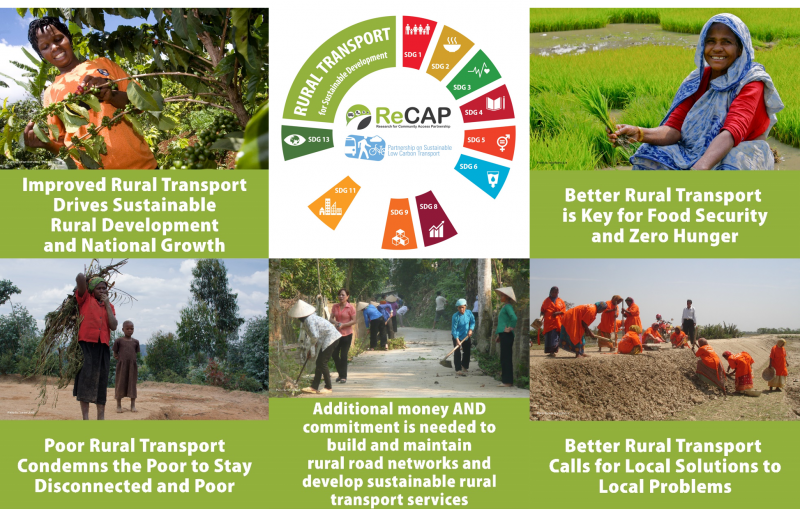Five Key Messages Underlining the Critical Role of Rural Transport to Achieve the Sustainable Development Goals

A set of key messages on rural transport and SDGs has been developed to explain how rural transport plays a key role in realizing the Sustainable Development Goals adopted by world governments to define development policy up to 2030. Improved rural transport is key in fighting poverty, improving food security and social development. At present about 1 billion people lack access to an all season road and are because of that are largely disconnected from economic and social opportunities.
The key messages are developed by The Partnership on Sustainable, Low Carbon Transport (SLoCaT) in the context of a joint project with the UK Aid-funded Research for Community Access Partnership (ReCAP). The project began implementation in November 2016 and aims to further promote sustainable rural access as a viable component of the implementation strategies for achieving the Sustainable Development Goals (SDGs) and to ensure its inclusion in the high-level, multi-lateral development discourse on sustainable transport and rural development.
The key messages will serve as the cornerstone of a wide spread advocacy campaign over the next 18 months. They were developed through a comprehensive consultation process to determine key themes and topics to be prioritized in the SLoCaT Partnership’s advocacy activities on rural transport. Based on the feedback and input gathered from more than 130 stakeholders five key messages were formulated to promote the critical role of rural transport in achieving the SDGs:
1. Improved Rural Transport Drives Sustainable Rural Development and National Growth: Good rural road infrastructure and services promote connectivity and social cohesion, drives commercial activities as well as accessibility to social and economic facilities necessary to counteract poverty, isolation and social exclusion.
2. Better Rural Transport is Key for Food Security and Zero Hunger: Improving rural access can lead to lower costs for farm inputs and lower transport costs for marketed outputs, thus increasing agricultural production to enhance food security.
3. Poor Rural Transport Condemns the Poor to Stay Disconnected and Poor: Access to markets and employment opportunities through better rural transport infrastructure and services is an essential pre-condition to generating rural income and thus reduce poverty.
4. Additional money AND commitment is needed to build and maintain rural road networks and develop sustainable rural transport services: Existing funding sources need to be expanded and new funding sources need to be developed, piloted and implemented not only for building but also for managing and maintaining the asset.
5. Better Rural Transport Calls for Local Solutions for Local Challenges: Rural access challenges require local resource-based solutions that are compatible with the local road sectors and conditions.
Successful scaled-up implementation of rural transport will contribute to realizing SDG 1 to alleviate poverty; SDG 2 to achieve zero hunger and ensure food security; SDG 3 to ensure health and well-being; SDG 4 to provide access to education; SDG 5 to empower women in rural areas; SDG 6 to facilitate access to clean water and sanitation; SDG 8 to promote inclusive growth and economic opportunities; SDG 9 an SDG 11 to contribute to sustainable infrastructure and communities for all; and SDG 13 to increase climate resilience and adaptation in rural areas.
A report summarizing the results of the consultation process is available here.
For more information, please visit www.research4cap.org or www.slocat.net/ruraltransport.
————————————————————-
The Partnership on Sustainable, Low Carbon Transport, in partnership with, and support of the UK Aid-funded Research for Community Access Partnership, promotes sustainable rural access as a viable component of the implementation strategies for achieving SDG and to ensure its inclusion in the high-level, multi-lateral development discourse on sustainable transport and rural development. For more information, please visit www.slocat.net/ruraltransport.